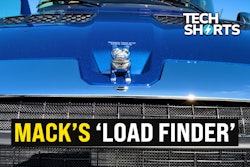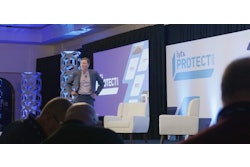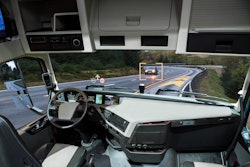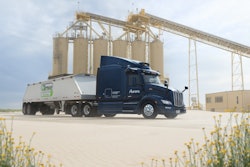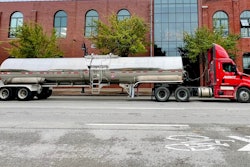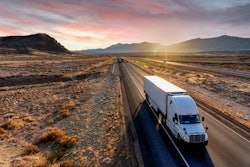“How is my driving?” That’s not an uncommon sentence – accompanied by a phone number – to see on the rear of a trailer when driving behind a semi-truck on the interstate.
Alan Kitzhaber, a recently retired trucker of 34 years and CCJ sister publication Overdrive's 2025 Trucker of the Year, took to answering that question back in the early 2000s, but he wanted proof to share.
Kitzhaber first rigged up a point-and-shoot camera that had a record function, which back then only recorded for a handful of minutes. When he called that number, it wasn’t just his word against another driver.
“I just got so fed up with these guys cutting you off and doing really aggressive type driving. You could call the company and tell them what happened, but it's your word against theirs. I thought, ‘If I have a little video clip I can send them, that answers all of those questions,'” he said. “That was my motivation. I just have a real dislike for aggressive drivers. There's no place for it.”
Road-facing cameras mounted to the dashboards of semi-trucks are relatively common now, but they often come with a hefty cost associated with additional features that enable driver coaching. That may not fit the budget for smaller fleets seeking to install dash cameras, whether for insurance purposes, accident exoneration or because a broker requires it.
But there are other options on the market.
A simple solution
A quick search on Amazon or eBay will showcase a number of options – some as low as $30, but “you get what you pay for,” said Adam Robertson, who heads marketing at Cobra Electronics.
Cobra’s entry-level SC 100 dash camera can be purchased on Walmart’s website for $116. You can also find it, as well as other brands like Rand McNally, at truckstops across the U.S. Cobra, which also offers CB radios, is one that markets primarily to owner-operators and small fleets as its cameras aren’t connected to a telematics system that delivers driver coaching and alerts for things like hard braking, speeding and seat belt usage.
Cobra cameras are, however, enabled to capture events triggered by the accelerometer, whether it’s a hard brake or collision event, or by pressing a button. They come with SD cards with enough storage for a couple days’ worth of continually rolling footage before the driver has to delete video, which can be done via mobile app. When events are triggered, that video is placed in a separate part of storage that cannot be overwritten.
Those are the types of features – along with proper 4K resolution – that you get with Cobra’s $100 to $300-range cameras. That’s four times the resolution of 1080p, which is what you often get with lower-cost options.
Robertson said professional drivers often prefer that higher resolution because driving provides the challenge of varied lighting that can affect image quality that can mean the difference between capturing video of the event or a license plate if, for example, a truck passes under a tree or bridge, causing shadow.
There’s a decision between cost and quality, he said, adding that some drivers sacrifice quality in favor of a lower price because they think the likelihood of something happening is slim.
They don’t want to “spend a couple hundred dollars on a dash camera until it's too late, and they wish they had it. Unfortunately, we find a lot of our customers have either directly been involved in an incident or have had someone close to them or within their fleet have an incident, and now they're reacting and buying,” Robertson said. “Then what happens is they step into this sea of options, especially once they hit Amazon, and they get nervous about trusting a low-quality option.”
He warned that there are models on the market that claim 4K resolution but that actually only take regular 1080p picture and duplicate every line three times to make it 4K, which diminishes detail.
While owner operators and small fleets – what Rand McNally calls consumer customers – need quality resolution, they don’t necessarily need (or want) what the company’s fleet customers are leaning toward: the driver coaching aspect, said Jonah Towler, senior product consultant at Rand McNally, which offers both a basic dash camera that simply records the road ahead as well as a camera system with a driver coaching platform.
“We've seen fleet customers trend towards wanting more of the AI and remote functionality. It's important who the buyer is, because if you're an owner operator, you have no interest in coaching your own behavior most of the time or tracking yourself,” Towler said. “I think that fixed dash cam has become more of a consumer product naturally over time. I still think there is a bit of a place for it, but … fleets are leaning towards having that extra functionality now, and they often are also getting pushed toward it by insurance, or their brokers, or whoever has any influence in that space.”
He said the small fleets and owner operators like Kitzhaber are really only interested in forward-facing recordings for exoneration purposes in the event of accident-related litigation.
A different approach
Kitzhaber, who operated for almost 15 years under his own authority as Oak Ridge Transport, did his research, but he opted to forego the options on the market that specifically cater to the commercial trucking industry.
“What I had was getting the job done,” he said.
In 2013, he bought an actual camcorder: a Sony HDR-CX760V Handycam with optical image stabilization for clarity. At the time, he paid about $1,300, but there are used options on sites like eBay in the $300 range.
He tried two different options, seeking the best resolution, but when the second option failed – he suspects due to the vibrations of the truck – he went back to the 2013 camera, and it’s “still going strong,” despite the packaging saying it wasn’t designed to be mounted to vehicles.
Kitzhaber mounted the Handycam behind the driver-side windshield wiper of his 1995 Kenworth T600 so if it was raining or snowing, the wipers would ensure visibility.
“I found an area where I wanted to mount it, and then I put down Saran Wrap and then put Bondo on top of that just to form fit the dash area. On top of that, I put up a piece of half-inch plywood that was like two inches square,” he said. “On top of that, I took the top of a tripod – the part that you screw your camera to – and I epoxied that to the plywood, and that way I can easily, with the flip of a little lever, can take the camera on and off.”
He popped a 512GB SD card into it and recorded nonstop until the end of his workday when he would clear any unneeded footage.
If something happened – whether another professional driver cut him off or tailgated a four-wheeler – he said he would turn the recording function off after the event occurred and turn it right back on to create a divide in the video so he could easily find the event.
“It has saved my butt a couple of times with accidents,” Kitzhaber said. “It only takes one bad thing to happen, and you get involved in an accident, and you can't prove one way or the other. That camera could be the big difference.”


